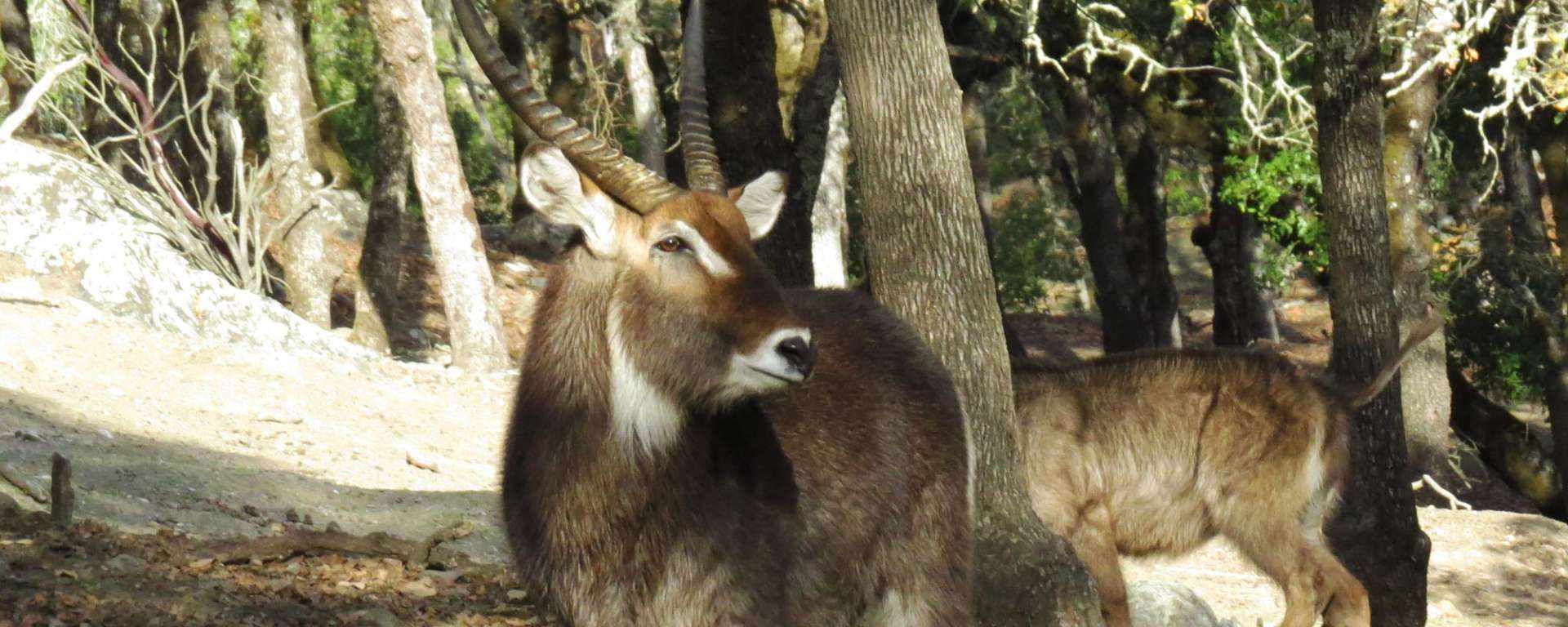Description
Waterbuck are large, shaggy antelope with a coarse coat that is reddish-brown when they are young and darkens to grey with age. White facial markings are found on their noses, eyebrows, ears and throat. The most obvious feature of this antelope is a large white ring surrounding the rump. This follow-me mark is most apparent in the common ellipsis waterbuck, K. e. ellipsiprymnus, the sub-species found at Safari West. Only males have horns, which are heavily ridged and curve forward, growing 1.5-3 ft (55-100 cm) long.
Classification
- Class
- Mammalia
- Order
- Cetartiodactyla
- Family
- Bovidae
- Genus
- Kobus
- Species
- K. ellipsiprymnus
- Conservation Status
- Least Concern
Key Facts
- Height
- 3-4 ft (~100-130 cm)
- Weight
- 330-660 lb (~150-300 kg)
The IUCN Red List describes Kobus ellipsiprymnus as a species of Least Concern with a widespread population of about 200,000 individuals. This species is prone to poaching and several populations are declining, if this trend continues then the species may warrant up-listing to Near Threatened in the future.
Social Life
Waterbuck live in herds comprised of males, females or mixed groups of 5-30 individuals. Once juvenile males begin to develop horns they will be ostracized from the rest of the herd, usually around 7-9 months of age. These young males form bachelor herds of 5-10 individuals with a distinct social hierarchy based on size and strength. At around 6-7 years of age, males become territorial and defend these territories as well as any females that enter it.
Habitat and Range
Waterbuck are found in scrubs, savannas, and woodlands throughout sub-Saharan Africa. They prefer grassland habitats near a permanent source of water. There are two main sub-species, the common waterbuck K. e. ellipsiprymnus that is found in southeast Africa and the Defassa waterbuck, K. e. defassa that is found in northeastern, central, and western Africa.
Diet
Waterbuck are herbivores that consume a variety of grasses, reeds and leaves. When grass is difficult to find, waterbuck eat other herbs to satisfy their needs. These antelope are very water dependent and remain close to a permanent water source year-round.
Lifespan
Captive and wild lifespan of waterbuck are similar with a known maximum of 18 years.
Predators
Main predators include lions, leopards, hyenas, crocodiles and painted dogs.
Reproduction
Sexual maturity: Male: 14-18 months, Female: 12-14 months
Mating Season: Year-round
Birth Season: Peaks in August and November (Wet Season)
Gestation: 8.5-9 months
No. of Young: 1-2
- Information
-
Description
Waterbuck are large, shaggy antelope with a coarse coat that is reddish-brown when they are young and darkens to grey with age. White facial markings are found on their noses, eyebrows, ears and throat. The most obvious feature of this antelope is a large white ring surrounding the rump. This follow-me mark is most apparent in the common ellipsis waterbuck, K. e. ellipsiprymnus, the sub-species found at Safari West. Only males have horns, which are heavily ridged and curve forward, growing 1.5-3 ft (55-100 cm) long.
Classification
- Class
- Mammalia
- Order
- Cetartiodactyla
- Family
- Bovidae
- Genus
- Kobus
- Species
- K. ellipsiprymnus
- Conservation Status
- Least Concern
Key Facts
- Height
- 3-4 ft (~100-130 cm)
- Weight
- 330-660 lb (~150-300 kg)
- Conservation
The IUCN Red List describes Kobus ellipsiprymnus as a species of Least Concern with a widespread population of about 200,000 individuals. This species is prone to poaching and several populations are declining, if this trend continues then the species may warrant up-listing to Near Threatened in the future.
- Lifestyle
Social Life
Waterbuck live in herds comprised of males, females or mixed groups of 5-30 individuals. Once juvenile males begin to develop horns they will be ostracized from the rest of the herd, usually around 7-9 months of age. These young males form bachelor herds of 5-10 individuals with a distinct social hierarchy based on size and strength. At around 6-7 years of age, males become territorial and defend these territories as well as any females that enter it.Habitat and Range
Waterbuck are found in scrubs, savannas, and woodlands throughout sub-Saharan Africa. They prefer grassland habitats near a permanent source of water. There are two main sub-species, the common waterbuck K. e. ellipsiprymnus that is found in southeast Africa and the Defassa waterbuck, K. e. defassa that is found in northeastern, central, and western Africa.Diet
Waterbuck are herbivores that consume a variety of grasses, reeds and leaves. When grass is difficult to find, waterbuck eat other herbs to satisfy their needs. These antelope are very water dependent and remain close to a permanent water source year-round.Lifespan
Captive and wild lifespan of waterbuck are similar with a known maximum of 18 years.Predators
Main predators include lions, leopards, hyenas, crocodiles and painted dogs.Reproduction
Sexual maturity: Male: 14-18 months, Female: 12-14 months
Mating Season: Year-round
Birth Season: Peaks in August and November (Wet Season)
Gestation: 8.5-9 months
No. of Young: 1-2

